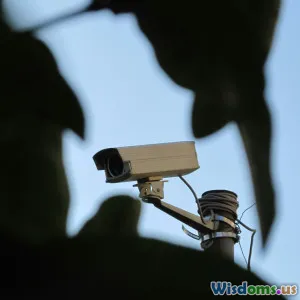
The Evolution of Spy Gadgets From Cold War to Now
14 min read Explore the fascinating evolution of spy gadgets from Cold War innovations to today's high-tech intelligence tools, illustrated with real examples and engaging insights. (0 Reviews)
The Evolution of Spy Gadgets From Cold War to Now
Introduction: Shadows, Secrets, and Science
In a world where nations constantly seek an edge, espionage sits at the darkest intersection of technology and intrigue. Imagine the tension of the Cold War: two nuclear powers locked in silent combat, their best minds inventing tools of deception and discovery hidden in plain sight. Fast forward to today’s hyper-connected landscape—spies aren’t just lurking in alleys with microfilm or disguised as birdwatchers. They exploit satellites, AI, and smartphones. How did we get here? The evolution of spy gadgets reveals not only the ceaseless creativity of intelligence agencies, but also poses urgent questions about privacy, politics, and ethics as surveillance tech infiltrates modern lives.
From Cloak-and-Dagger to Pocket Arsenal: A Timeline of Spy Gadget Evolution
The Cold War’s Gadgets: Tiny Tools, Giant Leaps
The Cold War, a period spanning the late 1940s through the early 1990s, ignited an unprecedented arms and intelligence race between East and West. Espionage wasn’t just about planting agents; it was a race of technology—a creative duel of mechanical ingenuity and deception.
Miniature Cameras and Concealed Weapons: The KGB famously employed the "F-21" camera: small enough to fit in a cigarette pack, capable of snapping covert images. Meanwhile, the CIA countered with tie-pin cameras and the legendary "Recta Agent" wristwatch camera. Spy gear wasn’t limited to photographs—dead drops used innocuous-looking hollow bolts or hollowed out coins containing microfilm.
One of the most iconic gadgets—the lipstick pistol, known as the "Kiss of Death," packed a single 4.5mm shot into what appeared to be a tube of lipstick. Another classic: the umbrella gun, infamously used in 1978 to assassinate Bulgarian dissident Georgi Markov in London with a ricin pellet.
Listening Devices: The MI6 and ‘The Thing’ In 1945, the Soviets gifted the US ambassador a wooden wall plaque of the Great Seal of the United States. Unbeknownst to the recipients, Leonard Theremin (of theremin musical instrument fame) had embedded a sophisticated passive listening device, later known as "The Thing." It contained no battery, activated remotely by radio waves, enabling years of eavesdropping before its discovery in 1952—a technological marvel for its time.
Communications and Concealment Invisible inks, microdots (tiny camouflaged photographs containing thousands of words), and clandestine radios enabled secure secret message passing. The CIA’s "Burst Transmitter," for instance, could broadcast coded bursts of signals that were nearly impossible to intercept except by designated listening posts.
Quotable Insight:
“Our invisible weapons weren’t bombs or bullets. They were the gadgets you least expected—an umbrella, a coin, even a gift on the wall.” —Former MI6 Field Officer (as cited in BBC interview, 1996)
Détente, Technology Growth, and the Digital Dawn
With the Cold War gradually cooling, spies began to experiment with computer-driven innovations well before such devices were fixtures in everyday homes.
Early Tracking and Bugging: Miniaturization enabled audio bugs to shrink; the NSA’s Operation SHAMROCK by late 1970s already harvested global telecommunications traffic. Tracking devices were fitted inside diplomatic briefcases or even embedded into shoes. The evolution of cryptography gave rise to portable cipher machines—some, like the Soviet Fialka, using multiple rotors and punch cards, while the CIA quietly transitioned to advanced electronic encryption devices.
Night Vision and Surveillance: Infrared scopes once reserved for armored vehicles began to shrink, appearing in hand-held arrangements. By the late 1980s, surveillance gadgets exploited low-light and thermal imaging, laying groundwork for systems later common in modern law enforcement.
The 21st Century: Enter the Digital, Connected Age
The end of the Cold War transformed intelligence priorities, but it also coincided with a digital revolution. Spies now had access to compact computers, GPS, satellites, powerful encryption, remote sensors, and, crucially, the internet.
Satellite Eyes and Ears: Modern reconnaissance satellites, like the U.S. KH-11 "KENNAN" series, deliver real-time, high-resolution imagery indistinguishable from what’s found in some sci-fi thrillers. China and Russia have deployed their own advanced remote sensing platforms, kicking off a new high-tech spy satellite race.
Example: The 2013 Snowden leaks revealed the U.S. government’s reliance on PRISM, a surveillance program that collected data from major tech companies. Tools now not only collect human intelligence (HUMINT) but signal intelligence (SIGINT) at unprecedented, even global, scales.
Digital Disguise and Social Engineering: Instead of forging documents, today’s spies may craft entire digital identities—online aliases flushed out with social media presence, AI-generated photographs, and encrypted messaging clients.
Wearables and Domestic Spying: - Smartwatches and Fitbits: Not only track steps, but location and health metrics—valuable for tracking someone’s habits or movement. - Spy Glasses: Equipped with micro-cameras, these resemble regular eyewear but can record high-quality audio/video. Law enforcement and private sector security use them for undercover work.
AI, Biometrics, and Next-Level Surveillance: Modern sensors identify personnel using facial recognition, gait analysis, and behavioral patterning—often whether the person even knows. Governments invest in apps that can eavesdrop or activate microphones remotely, with malware tools (like Pegasus, developed by Israel’s NSO Group) turning everyday phones into unwitting spy gadgets.
Iconic Examples: The Gadgets That Shaped Espionage
1. The Dead Drop Rat
One of the archetypes of Cold War tradecraft: hollowed-out papier-mâché rats used as containers for secret messages or microfilm, placed in prearranged spots for agents to retrieve.
2. The Minox Miniature Camera
First popularized in the 1950s and 1960s, the Minox B was pocket-sized and capable of capturing fine details in difficult circumstances, making it the camera of choice for both sides.
3. Shoe Heel Transmitters
Soviet KGB agents are known to have slipped bugging devices and even thin microfilm into the hollowed heels of their shoes for easy smuggling past border controls.
4. The Berlin Tunnel (Operation Gold/Operation Stopwatch)
In 1955, the CIA and MI6 tunneled under Soviet-controlled Berlin and tapped the Russian military communication lines. The listening devices and cable-tapping equipment used in this operation were insanely advanced and secured months of critical intelligence before discovery.
5. Smart Dust
An experiment first conducted by DARPA (Defense Advanced Research Projects Agency) in the 1990s, smart dust consists of microscopic sensors that detect movement, light, or sound—raising the specter of near-invisible surveillance grids for modern intelligence work.
6. USB-based Espionage
In 2008, the Stuxnet worm—a joint US-Israel cyber-weapon—was delivered through infected USB sticks, sabotaging Iran’s nuclear program. In this instance, the common USB stick became a tool more effective than any camera or gun.
The Impact of Technology: Power, Ethics, and Cat-and-Mouse
How Advanced Are Today’s Spy Gadgets?
Miniaturization and Stealth: We now have cameras the size of pinheads and microphones that can pick up whispered conversations through a wall or window. Some of the world’s top intelligence agencies invest billions annually to miniaturize, encrypt, and augment intelligence-gathering tools.
Drone Surveillance: From bird-sized micro aerial vehicles (MAVs) mimicking insects, tested by the U.S. Defense Department, to quadcopters used by everyone from street protestors in Hong Kong to Russian soldiers in Ukraine, surveillance is airborne and accessible.
Biometric and Digital Intrusion: Facial recognition cameras can scan thousands of faces in seconds, used for security, law enforcement, and by intelligence agencies to track suspects worldwide. AI systems analyze patterns in communications to flag threats before they manifest—sometimes accurately, sometimes at a civil liberties cost.
Insider Quote:
“Technology gives us data oceans. The challenge is both building the better net and knowing what to toss out.” —Michael Hayden, Former NSA Director
The Risks and Consequences
Against Individual Privacy Gadgets once reserved for covert operatives have trickled down, appearing in the hands of journalists, activists, business competitors—even common criminals. The proliferation of inexpensive drones, spyware apps, and miniature recorders means nearly anyone can become an amatuer spy.
International Norms and Tensions Every new gadget or exploit can spark an arms race: cyber-espionage tools developed in the US wind up imitated or weaponized abroad. When China’s Ministry of State Security used malware against Western companies, it led to sweeping new security protocols and an emphasis on ‘offensive cyber’ by nations worldwide.
Legal and Ethical Fault Lines Spy gadgets challenge the line between safety and surveillance. Debates rage over their use: Should law enforcement utilize face scanners? Should intelligence agencies be allowed to hack private devices for the sake of ‘national security’? International law lags behind the pace of innovation.
Quote:
“The very same tools that expose corruption can threaten democracy if misused.” —Edward Snowden
What’s Next? The Future of Espionage Technology
Spy gadgets have never stopped surprising us. If history holds, tomorrow’s innovations will outmatch yesterday’s deepest imaginings.
Quantum Communications and Unhackable Networks
Quantum encrypted messaging, tested by China between Beijing and Shanghai, promises nearly unbreakable channels, rendering traditional wiretaps obsolete. At the same time, quantum computers threaten to unravel encryption most spy agencies (and banks) have relied on for decades.
Autonomous Intelligence Gathering
AI-driven algorithms can autonomously sift massive troves of surveillance data, identifying suspects, or even predicting likely criminal activity. The same tools could fine-tune intelligence operations, reducing the risk for operatives in the field.
Bioengineered Sensor Gadgets
Researchers in 2023 demonstrated beetles with micro-implants controlled via Bluetooth, probing the intersection of biological adaptation and technology—a surreal evolution of ‘bug’ technology.
Fabric Integrated Sensors
Researchers are embedding sensors onto wearable fabric—or even under the skin—setting the stage for nearly undetectable intelligence “platforms.”
Conclusion: Lessons From the Shadows
From lipstick pistols and wooden bugs to satellites, malware, and quantum encryption, the saga of spy gadgets is a story of endless human creativity meeting existential necessity. For every breathtaking leap in technology designed to unearth secrets, there is an answer in countermeasures and new risks introduced into society. Spy gadgets undoubtedly gave intelligence agencies advantages, but they also democratized surveillance, introducing powerful tools—and dangerous temptations—into the hands of all.
As gadgets evolve, so too must our laws, our oversight, and our public discourse. The next time you slip a smart device into your pocket, remember: the dividing line between spycraft and everyday life has never been thinner. Staying informed about this evolution isn’t just for spies. It’s the responsibility of all of us—because, in today’s digitized world, all the world’s a stage for secrets.
Rate the Post
User Reviews
Other posts in Military and Intelligence Secrets
Popular Posts















